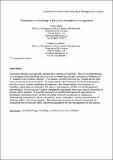Files in this item
Trajectories of rewilding : a taxonomy of wildland management
Item metadata
| dc.contributor.author | Deary, Holly | |
| dc.contributor.author | Warren, Charles R. | |
| dc.date.accessioned | 2019-02-19T00:33:28Z | |
| dc.date.available | 2019-02-19T00:33:28Z | |
| dc.date.issued | 2019-02-23 | |
| dc.identifier | 252017154 | |
| dc.identifier | b5108590-8612-4324-92bb-0edc60dd4290 | |
| dc.identifier | 85042212755 | |
| dc.identifier | 000470326900006 | |
| dc.identifier.citation | Deary , H & Warren , C R 2019 , ' Trajectories of rewilding : a taxonomy of wildland management ' , Journal of Environmental Planning and Management , vol. 62 , no. 3 , pp. 466-491 . https://doi.org/10.1080/09640568.2018.1425134 | en |
| dc.identifier.issn | 0964-0568 | |
| dc.identifier.other | ORCID: /0000-0003-4449-4068/work/60195855 | |
| dc.identifier.uri | https://hdl.handle.net/10023/17090 | |
| dc.description | The research was funded by the Carnegie Trust for the Universities of Scotland. | en |
| dc.description.abstract | Rewilding, though a young term, already has numerous meanings. We use Q-methodology to investigate understandings and practices of rewilding amongst managers of wildland on 17 estates in the Scottish uplands. The estates, covering 207,200 ha, include all the main land ownership types in Scotland. All respondents value wildness and biodiversity highly, but the Q-study reveals significant divergence in the interpretations and practices of rewilding, especially concerning (i) the value of naturalness, (ii) the use of management interventions, (iii) the value of cultural heritage and traditional land uses, and (iv) the place of people within wildland. A tripartite taxonomy of wildland management approaches is developed, identifying three ‘centres of gravity’ along the continuum of viewpoints, emphasising respectively nature’s autonomy, active restoration, and the maintainance of wildness within cultural landscapes. The taxonomy provides an analytic framework for evaluating the diverse and often conflicting aspirations for the management of wild places. | |
| dc.format.extent | 26 | |
| dc.format.extent | 812584 | |
| dc.language.iso | eng | |
| dc.relation.ispartof | Journal of Environmental Planning and Management | en |
| dc.subject | Q-methodology | en |
| dc.subject | Rewilding | en |
| dc.subject | Scotland | en |
| dc.subject | Taxonomy | en |
| dc.subject | Wildland | en |
| dc.subject | GE Environmental Sciences | en |
| dc.subject | HD28 Management. Industrial Management | en |
| dc.subject | 3rd-NDAS | en |
| dc.subject | BDC | en |
| dc.subject | R2C | en |
| dc.subject | SDG 15 - Life on Land | en |
| dc.subject.lcc | GE | en |
| dc.subject.lcc | HD28 | en |
| dc.title | Trajectories of rewilding : a taxonomy of wildland management | en |
| dc.type | Journal article | en |
| dc.contributor.institution | University of St Andrews. School of Geography & Sustainable Development | en |
| dc.contributor.institution | University of St Andrews. St Andrews Sustainability Institute | en |
| dc.identifier.doi | 10.1080/09640568.2018.1425134 | |
| dc.description.status | Peer reviewed | en |
| dc.date.embargoedUntil | 2019-02-19 |
This item appears in the following Collection(s)
Items in the St Andrews Research Repository are protected by copyright, with all rights reserved, unless otherwise indicated.

